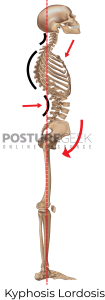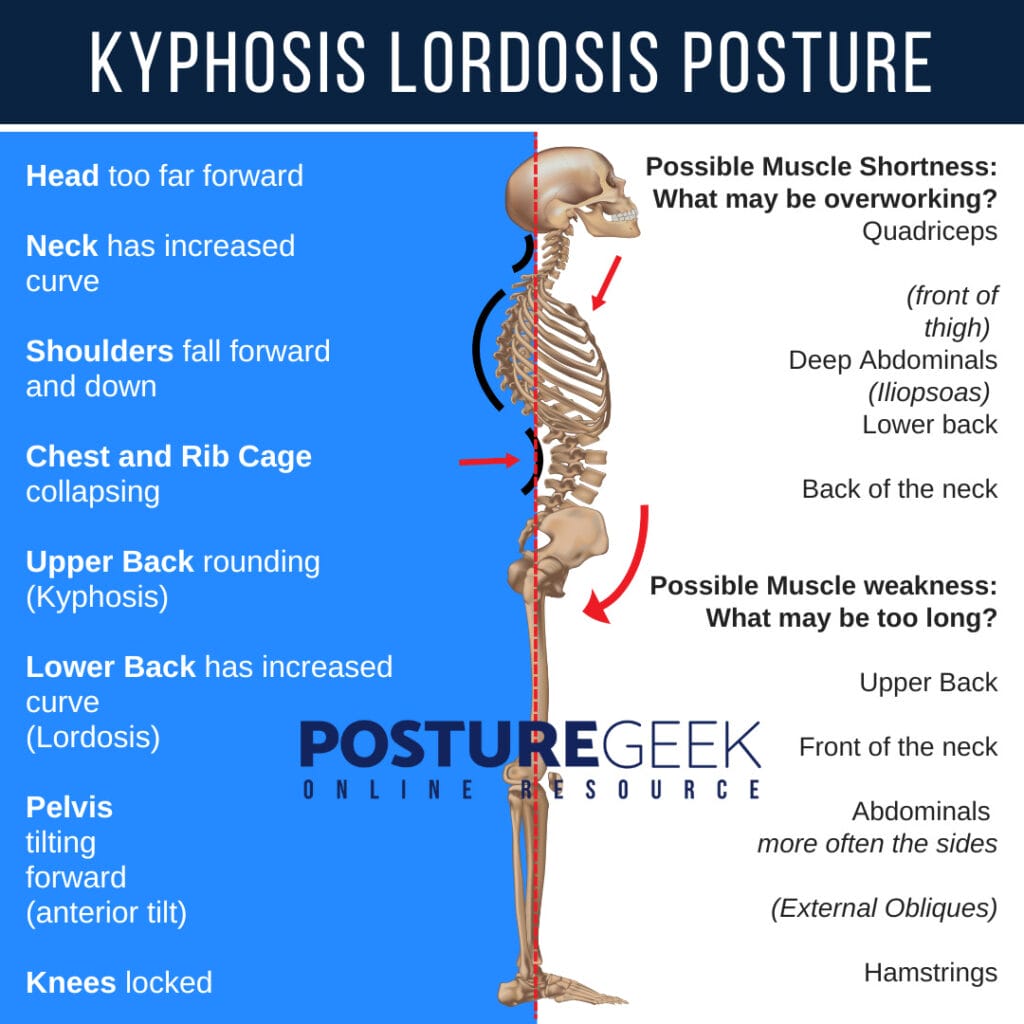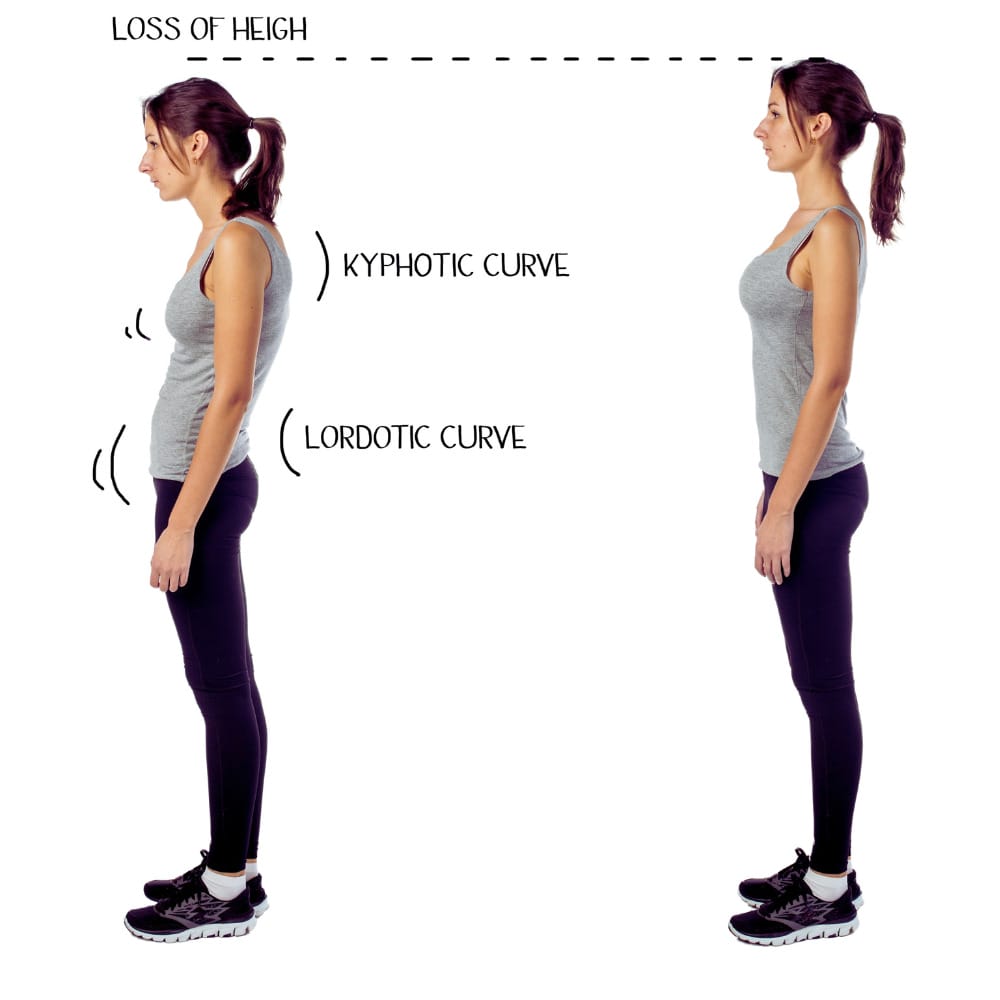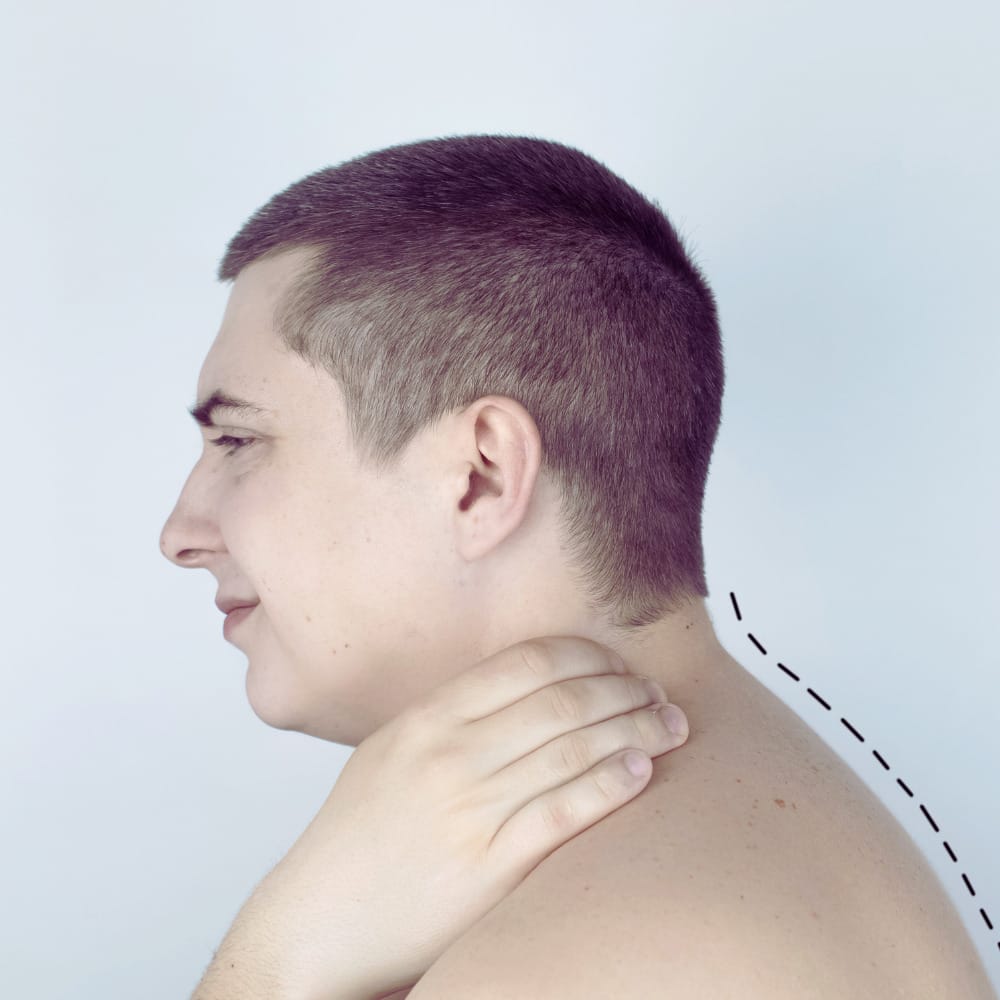Kyphosis Lordosis Posture: What's Happening to My Body?
- Updated - February 26, 2025
Our body posture plays a significant role in our overall health and wellbeing. However, this can change as we age and cause discomfort or even pain if left untreated. Kyphosis lordosis is one such condition that can affect the spine over time.
What is Kyphosis Lordosis Posture?

Kyphosis Lordosis is a condition where your spine’s curves are exaggerated at the different spinal segments. To start, you need to understand what Kyphosis and Lordosis are.
Kyphosis is a curving of the spine, most commonly found in the upper back (thoracic spine) region. It usually happens when there is an outward curvature, which leads to a rounder appearance of your upper back and shoulder area.
Lordosis is a curving of the spine, most commonly found in the lower back (lumbar spine) region. It usually happens when the spine curves forward. It is often seen with an anteriorly tilted pelvis.
Kyphosis Lordosis Posture Pattern is when both areas of the spine, the Thoracic and Lumbar, have exaggerated curves – producing a sway back, rounded upper back, and prominent lower back appearance. Sway back posture represents an altered alignment characterized by specific pelvic and thoracic changes, highlighting its impacts on the musculoskeletal system. This posture type can be caused by several factors, such as muscle imbalances, genetics, poor sitting posture, weak core muscles, too much time spent in activities such as sitting or texting, and weight gain.
Can you have Kyphosis and Lordosis at the same time?
Yes, it is possible to have Kyphosis and Lordosis simultaneously. Many people who have one of these conditions also have the other. While the causes of one may differ from the other, they can become compounded as the body compensates for its structural imbalances.
What causes Kyphosis Lordosis posture?
There are many different causes of Kyphosis Lordosis Posture. Some of the most common include:
- Poor posture: One of the most common causes of Kyphosis Lordosis Posture. When you spend long periods in a seated or standing position, your muscles can weaken, and your spine can lose its natural curvature. This can cause the spine to become more curved, leading to Kyphosis Lordosis Posture.
- Injury: A traumatic injury, such as a car accident or fall, can cause damage to the spinal cord and lead to Kyphosis Lordosis Posture.
- Genetics: Some people are born with natural curves in their spine that can lead to Kyphosis Lordosis Posture.
- Osteoporosis: This condition causes the bones to become thin and brittle, leading to a loss of bone density in the spine and an increase in curvature.
- Paget’s disease: This rare condition causes the bones to become weak and deformed, leading to Kyphosis Lordosis Posture.
- Rheumatoid arthritis: This chronic inflammatory disease can affect the spine and lead to Kyphosis Lordosis Posture.
- Scheuermann’s Kyphosis: Scheuermann’s Kyphosis (or Scheuermann’s Disease) is where the vertebrae develop a wedge shape, which stiffens over time and can grow worse with age.
- Anterior pelvic shift: This shift contributes to the postural misalignment observed in sway-back posture, leading to functional disorders and stresses on the musculoskeletal system.
Symptoms and Effects
Common Symptoms
Kyphosis can manifest through a variety of symptoms that can significantly impact daily life. Some of the most common symptoms include:
- A visible hump or curvature of the upper back
- Forward head posture
- Rounded shoulders
- Back pain and stiffness
- Fatigue
- Breathing difficulties
- Muscle tightness
In more severe cases, Kyphosis can also lead to:
- Sensation loss in the legs
- Weakness
- Numbness
- Tingling
These symptoms can range from mild to severe and often worsen if left untreated. Recognizing these signs early can help in seeking appropriate treatment and preventing further complications.
Body Image Concerns
Beyond the physical symptoms, Kyphosis can also have a profound impact on a person’s body image and self-esteem. The visible curvature of the upper back can make individuals feel self-conscious and embarrassed, which may lead to social isolation, anxiety, and even depression. This is particularly challenging for children and teenagers, who may feel out of place among their peers. Addressing these emotional and psychological aspects is crucial for a holistic approach to managing Kyphosis.
Discover a practitioner near you.
Looking for a practitioner near you? Our extensive network of qualified professionals is here to help you.
Diagnosis and Testing
Medical History and Physical Exam
Diagnosing Kyphosis involves a thorough evaluation, including medical history, physical examination, and imaging tests. During the medical history assessment, a practitioner will ask about symptoms, lifestyle habits, and any previous injuries or conditions that might have contributed to developing Kyphosis. Key areas of focus include:
- Posture and movement patterns
- Exercise and activity levels
- Previous injuries or medical conditions
A physical exam will then assess the curvature of the spine, balance, and range of motion. Your practitioner may perform specific tests such as:
- Adam’s forward bend test to evaluate the slope of the spine
- Neurologic evaluation to check for sensation loss, weakness, or numbness in the legs
Diagnosing and determining the severity of the curvature may require imaging tests such as X-rays, CT scans, or MRI. These tests provide detailed images of the spine, helping to identify the extent of the kyphotic posture and any underlying issues.
By understanding Kyphosis’s symptoms, effects, and diagnostic process, individuals can take proactive steps toward managing their condition and improving their overall quality of life.
How do you know if you have Kyphosis Lordosis Posture?
Any change in a spinal curvature may result in discomfort, stiffness, balance problems, and improper posture. Spinal deformities can be defined as any departure from curvature in the spine.
Kyphosis is often associated with neck stiffness, leading to neck pain, making it challenging to look forward. In addition, excessive Lordosis can cause lower back pain or discomfort.
Kyphosis Lordosis posture comprises elements of several specific alignment issues:
- The head and neck display distinctive characteristics of the forward head posture,
- The upper back (thoracic spine) presents with an increased thoracic Kyphosis (exaggerated posterior rounding or curvature of the spine) and the lower back with a deep Lordosis (an exaggerated anterior curve of the spine). In some cases, sway-back posture may present with a shorter lumbar lordosis, which can lead to functional disorders and muscle imbalances.
- The pelvis also shows an excessive anterior tilt (tipping forward), possibly affecting the degree to which the lower back curves forward, creating an exaggerated lumbar spine curve.
What are some characteristics of Kyphosis Lordosis Posture?

Muscular imbalances can influence Kyphosis and Lordosis. For example, the muscular imbalance between the front and back of the body in Kyphosis and Lordosis postures may lead to overworking muscles, muscle weakness, or muscle tightness with corresponding compensations.
In some cases, the upper back may present with thoracic Kyphosis extended into the upper part of the lumbar spine, leading to various muscle imbalances.
This can be seen as:
The Head resting too far forward
The head is pulled forward due to prolonged sitting or standing and can be seen as a stooped posture.
Neck has an increased curve
The head’s position contributes to the neck (cervical spine) having an increased curve, creating tension and pain in the shoulder girdle muscles.
Shoulders are falling forward and down, while the chest and rib cage collapse
The excessive curve of the neck causes the shoulders to roll forward, which shifts the chest and rib cage downward, giving it a collapsed or sunken chest look.
The Upper Back is rounding (Thoracic Kyphosis)
Additionally, the upper back rounds from being pulled forward, creating a kyphotic curve in the spine.
The lower back has an increased angle (Lumbar Lordosis)
Lumbar Lordosis is the increased angle in the lower back due to an increased rounding of the lumbar vertebrae caused by this extended sitting or standing position.
Pelvis tilting forward
The lordotic curve is exaggerated due to the anterior tilt of the pelvis.
Knees locked
Knees may lock when standing or walking, which can cause even more pain and discomfort.
Which muscles may be short (tight) in Kyphosis Lordosis Posture?
The shortened muscles in Thoracic Kyphosis of the upper back are often:
- Pectoralis Major and Minor (the Chest Muscles),
- Anterior Deltoid,
- Serratus Anterior,
- Upper Trapezius,
- Levator Scapula and
- Scalenes.
The shortened muscles in Lordosis of the lower back include:
- Quadriceps, in particular Rectus Femoris,
- Gluteus Medius and Minimus,
- Iliopsoas (with Rectus Femoris these are hip flexors),
- Rectus Abdominus and
- Transverse Abdominus.
Which muscles may be weak in Kyphosis Lordosis Posture?
Weakness in muscles that stabilize or extend out of the spine (Upper Back) is a common contributor to postural imbalance. Weak muscles include:
- Upper Back
- Front of the neck
- The lower and middle parts of the Trapezius and rhomboid muscles
- Abdominal Muscles – more often the sides (External Obliques)
- Hamstrings
Seeing the Pattern in the Three Planes

Understanding your posture goes beyond just noticing a forward head or a rounded back—it also involves recognizing how these deviations appear in the three primary anatomical planes:
- Sagittal Plane (Side View):
- What You See: When viewed from the side, the sagittal plane highlights the forward or backward curvatures of the spine.
- Relevance to Kyphosis & Lordosis:
- Kyphosis: Presents as an exaggerated backward (posterior) curvature of the upper back.
- Lordosis: Appears as an increased forward (anterior) curvature of the lower back.
- Observation Tip: Standing sideways in front of a mirror or using a side-profile photo can help you identify if your spine curves excessively in either direction.
- Frontal Plane (Front/Back View):
- What You See: This view reveals asymmetries between your body’s left and right sides.
- Relevance to Kyphosis & Lordosis:
- Although these conditions are primarily identified in the sagittal plane (side view), muscle imbalances and compensatory shifts can sometimes cause a visible lean or uneven shoulder and hip levels in the frontal view.
- Observation Tip: Look at your posture in a full-length mirror or ask someone to check if your shoulders, hips, or head appear misaligned or unevenly positioned.
- Transverse Plane (Top/Bottom View):
- What You See: This horizontal perspective helps reveal rotational aspects of the spine and pelvis.
- Relevance to Kyphosis & Lordosis:
- Sometimes, the spine’s excessive curvature is accompanied by a slight twist, meaning your vertebrae may not be perfectly aligned. This rotational component can further affect how your muscles balance around the spine.
- Observation Tip: Although less obvious, noticing a twist in your shoulders or hips when viewed from above (or using a video analysis during movement) can indicate that rotational issues contribute to your postural imbalance.
Integrating These Views for Better Posture Analysis
By assessing your posture in all three planes, you gain a comprehensive understanding of your spinal alignment. This multidimensional approach highlights the visible curves of kyphosis and lordosis and uncovers any accompanying asymmetries or rotations. Whether you’re self-assessing or working with a healthcare professional, this method provides a more complete picture of your posture, paving the way for a tailored corrective strategy.
How is Kyphosis Lordosis Posture treated?
There is no one-size-fits-all treatment for Kyphosis Lordosis Posture. The treatment plan will vary depending on the condition’s cause and the severity of the symptoms. Some common treatments include:
- Health Care Practitioner: An allied health care provider, including a Physical Therapist, Chiropractor, Osteopath, or Pilates Instructor, may be recommended to help with symptoms and improve the overall postural alignment.
- Exercises: Specific exercises may be prescribed to improve strength, posture, and alignment.
- Posture Correction: Posture correction techniques can help re-educate the body on how to move more efficiently, allowing for improved posture.
- Lifestyle changes: Making simple changes to your lifestyle, such as improving your posture and avoiding prolonged periods of sitting or standing, can help reduce the symptoms of Kyphosis Lordosis Posture.
In extreme cases:
- Bracing or splinting: A brace or splint can support the spine and help correct the curvature.
- Surgery: In some cases (with severe Kyphosis), surgery may be necessary to correct the curvature of the spine.
Considerations: balancing the front and back of the body?
The greater the degree of bending in the spine, the greater the chance of developing a forward head posture.
PostureGeek.com Tweet

With excessive Kyphosis, the chest may become depressed, tight, and sunken, leading to the corresponding upper and middle back flexing or bending forward. This bending forward can increase the spine’s curve or “rounding” (upper back).
The balance between the front and back muscles of the upper body is clearly at odds in this pattern. The shortened muscles of the chest, upper shoulders, and upper abdominals work alongside the weakened middle and upper back muscles. This combined muscle-holding pattern can limit our ability to lift upright due to muscle weakness of the back and tightness of the front.
The lower back (Lumbar Spine) attaches to the pelvis. It can be affected by any changes in the position of the pelvis. With the Lordosis component of this pattern, the pelvis tips forward, increasing the lower back’s natural curve.
Excessive Lordosis, or an inward curve of the spine, can be caused by a variety of issues, including:
- tightness of the muscles on the front of the thigh (Quadriceps),
- tightness of the deep abdominal (Iliopsoas),
- tightness of the lower back (Erector Spinae).
Also, a weakness of the abdominal muscles (usually not including the Iliopsoas) and the hip extensors, Gluteus Maximus, and Hamstrings can lead to poor posture.
FAQ’s
Can scoliosis be linked with Kyphosis and Lordosis?
Yes, scoliosis is often linked with Kyphosis and Lordosis. The combined conditions can lead to postural imbalance and potential long-term health issues if not corrected. Therefore, it’s essential to receive advice from a qualified professional if you or your child are exhibiting any of these signs.
Will scoliosis screening show up Kyphosis and lordosis?
A scoliosis screening can uncover postural deviations, such as Kyphosis and Lordosis. This type of screening is typically done when children are under 16 years old to detect any postural abnormalities in their spines.
What is Postural Kyphosis

Postural Kyphosis is an excessive convex curvature in the spine. It is commonly found in the thoracic spine. This section of the spine consists of the twelve vertebrae joining the neck from above and the lower back below. The thoracic region can be further divided into upper and lower parts. The upper thoracic spine is the area above the middle of the ribcage. The lower thoracic spine is the area below the middle of the ribcage.
The most common cause is poor posture. This is when we adopt a slumped or hunched stance that places excessive stress on the spinal column. This can cause the vertebrae to buckle and the spine to curve unnaturally.
Other causes can include:
- Muscular imbalances: Muscles in the upper back (trapezius muscles) and front of the neck (sternocleidomastoid muscles) that stabilize or extend the head and neck can become tight and short, leading to an excessive curvature in the spine.
- Obesity: Excessive weight can place undue stress on the spine and cause it to curve abnormally.
- Genetic factors: Some people are born with a natural tendency to develop an excessive curvature in the spine.
- Congenital Kyphosis: This is a form of Kyphosis caused by abnormal development of the vertebrae that is present at birth.
- Trauma: A severe injury to the spine can cause it to curve unnaturally.
What is Kyphotic Deformity?
One of the most common postural patterns primarily affects the thoracic and cervical regions (Neck). However, it can also affect the lumbar area.
The kyphotic deformity is a spinal deformity that affects healthy bones, muscles, and joints. Still, it is also common after a fracture because the bone alignment isn’t corrected.
What is Lordosis?
The lumbar spine’s medial (increased spinal curvature ) curve increases, causing a visible protrusion in the abdominal area.
Lordosis has several causes, such as anterior pelvic tilt and weakness in hip and trunk extensors. In addition, this pattern can increase intradiscal pressure due to stress on the anterior longitudinal ligament of the vertebral body.
This postural asymmetry increases stress on the intervertebral discs due to shear, leading to degeneration.
What is shear?
Shear is the separation of two layers of material due to their different rates of linear movement. In biomechanics, shear stress is the physical force applied to an object perpendicular to its surface. This force can cause tissue damage and lead to the development of degenerative conditions such as arthritis.
Finally
Kyphosis lordosis posture is more than just an “abnormal” spine curve—it’s a signal from your body that something might be out of balance. Whether it’s due to muscle imbalances, genetics, or even lifestyle choices, your spine deserves some extra care.
By focusing on proper posture, strengthening those often-neglected muscles, and making mindful lifestyle changes, you can reduce unnecessary stress on your spine and work towards a healthier, more aligned body.
Remember, small adjustments today can lead to a stronger, pain-free tomorrow.
References
- Kendall, F.P., McCreary, E.K., & Provanc, P.G. (1993). Muscles, testing and function (4th ed). Baltimore, MD: Williams & Wilkins.
- Singla D, Veqar Z. Methods of postural assessment used for sports persons. J Clin Diagn Res. 2014;8(4):LE01-LE4. doi:10.7860/JCDR/2014/6836.4266
COMMON POSTURE PATTERNS
About the author
Find Expert Posture Practitioner Near You
Discover our Posture Focused Practitioner Directory, tailored to connect you with local experts committed to Improving Balance, Reducing Pain, and Enhancing Mobility.
